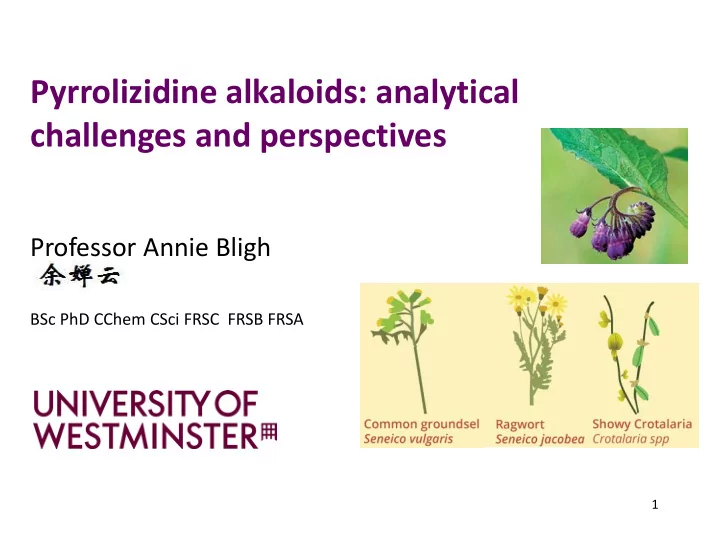

Pyrrolizidine alkaloids: analytical challenges and perspectives Professor Annie Bligh BSc PhD CChem CSci FRSC FRSB FRSA 1
Outline What are pyrrolizidine alkaloids (PA)? Why are they toxic? How can the insects manage the toxin? PA distribution in plants What are the analytical techniques available? Analytical challenges? Specificity and Sensitivity 2
What are pyrrolizidine alkaloids (PAs)? • PAs are plant defence weapons against herbivores. • They are present in several different plant species, for example, Eupatorium (Asteraceae) Crotolaria (Fabaceae) Senecio (Asteraceae) • PAs can occur in two forms, the tertiary free base and the N-oxide. 3
Some examples of Pas – free base Heliotrine Retrorsine Echimidine Senecionine 4
Common necine bases of PA Retronecine N-oxide 5
Why are they toxic? • Genotoxic: Capable of forming DNA adduct • Hepatotoxic: Veno-occlusive • Damage to heart and lung in high dose • The PA N-oxide itself, which is non-toxic per se, cannot be directly converted into toxic pyrrols and is hydrophylic and unable to passively pass through membranes • But N-oxide can be broken down to the free base in the gut of insects and mammals, where it is absorbed and further reduced to highly unstable toxic pyrrols. 6
7
1968, vol 217, 723 A. R. MATTOCKS Toxicology Research Unit, MRC Laboratories, Surrey, UK Toxicity of Pyrrolizidine Alkaloids A new class of metabolite, with a pyrrole-like structure, has been demonstrated in the tissues of animals poisoned by pyrrolizidine alkaloids. There is some correlation between the degree of hepato-toxicity and the amount of "pyrrole" found in the liver. Evidence has been found of the types of reactions such metabolites might undergo with tissue constituents. Mattocks AR. Chemistry and toxicology of pyrrolizidine alkaloids. 8 London: Academic Press, 1986.
How can the insects manage the toxin? around 40 insect herbivores feed on the PA- containing Senecio jacobaea insects are able to detoxify PAs in their host plant through N-oxidation By N-oxidation potentially toxic free bases are converted back into PA N-oxides that cannot be transformed into toxic pyrrolic derivatives Attract and deter: a dual role for PAs in plant–insect interactions 9
A: Larvae of the specialist moth Tyria jacobaeae feeding on their host plant Senecio jacobaea B: adult T. jacobaeae Both larvae and adults contain pyrrolizidine alkaloids and show warning coloring. Photo: Eric Thomassen 10
PAs distribution in plants • In the roots, the PAs were almost exclusively present as N-oxides and not as free bases. • In the shoots around 35% of the PAs were tertiary free bases. • Younger leaves have higher PA concentrations than the older leaves. • For example, adonifoline in Senecio scandens , flower > stem > root > leaf 11
What are the analytical techniques available? Separation Detection • thin layer chromatography (TLC) • colorimetry • high performance liquid • mass spectrometry (MS) chromatography (HPLC) • nuclear magnetic • UPLC resonance (NMR) • gas chromatography (GC) • chemiluminescence (CE) • supercritical fluid • Diode array detection chromatography (SFC) (DAD) However, most of these methods were strictly limited by the structural specificity of different types of PAs. 12
13
Colorimetric Not for OTO-PAs! Sensitivity: 5 ppm 14
Pre-column derivatization HPLC-DAD RET type of PAs Sensitivity 1 ppm 15
UPLC-MS/MS - dual parent ion scans • an effective strategy involving dual parent ion scans of diagnostic ion pairs by UPLC-MS/MS 16
Examples of PAs found in Senecio species. Senecionine N - oxide is the basic structure from which other PAs are formed. These senecionine type PAs have an otonecine (senkirkine) or retronecine ester base (e.g., senecionine) and a 12-membered 17 macro-cyclic ring
PIS profile of PAs and main PAs in S. vulgaris 18
UPLC-MS/MS - dual parent ion scans • Two Senecio herbs, Sececio vulgaris L. and S. scandens Buch.-Ham , showed great difference in their hepatotoxicity. • Significant difference was shown between their PAs’ fingerprint profiles. • In all, 53 PAs, including 22 RET-PAs, 14 RET-PA-N- oxides, 11 saturated-RET-PAs, 1 OTO-PAs, and 5 dehydro-OTO-PAs, were detected. • The average content of PAs in S. vulgaris was found about 25 times higher than that in S. scandens (1123.08 µ g/g vs 44.31 µ g/g) 19
20
Conclusions • What do we know about PAs ? Very toxic due to its reactivity to produce dehydroPAs Structurally diverse Challenges in extraction Challenges in specificity – impossible to have all the reference standards Challenges in sensitivity • Way forward? Better instrumentation Better database - algorithms 21
Acknowledgements Shanghai University of Traditional Chinese Medicine Professor Li Yang Professor Zhengtao Wang Thank you 22
Recommend
More recommend